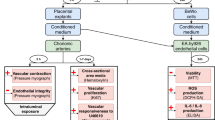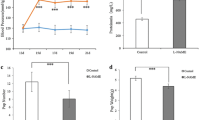Summary
The expression of endothelial nitric oxide synthase traffic inducer (NOSTRIN) in the placenta of the patients with pregnancy induced hypertension (PIH) was detected and its role in the pathogenesis of PIH was studied. The pathological changes in placental vessels were observed by HE staining, NO2−/NO3−, the stable metabolic end products of NO, was measured with nitrate reductase. The eNOS activity in placental tissues was assayed by spectrophotometry. Western blot analysis was applied to detect NOSTRIN expression. The incidence of thickening and fibronoid necrosis of placental vessels was significantly higher in women with PIH than in the normal group (P<0.01). The levels of placental NO2−/NO3− in PIH patients (27.53±7.48 μmol/mg) were significantly lower than in normal group (54.27±9.53 μmol/mg,P<0.01). The activity of eNOS was significantly decreased in PIH group (12.826±3.61 U/mg) as compared with that in normal group (21.72±3.83 U/mg,P<0.01). Western blot analysis revealed that both groups expressed 58 kD NOSTRIN, but the protein level was significantly higher in women with PIH than in the normal group (P<0.01). A significant negative correlation existed between the expression of NOSTRIN protein and the activity of eNOS in placental tissue of women with PIH (r=−0.57,P<0.01). It was concluded that the level of NOSTRIN expression in placenta of women with PIH was increased, which may play an important role in the pathogenesis of PIH.
Similar content being viewed by others
References
Zimmermann K, Opitz N, Dedio J. NOSTRIN: A protein modulating nitric oxide release and subcellular distribution of endothelial nitric oxide synthase. Proc Notl Acad Sci USA, 2004, 99(26):16150–16512
Harlow E, Lane D. Antibodies: A Laboratory Manual. NY: Cold Spring Harbor Laboratory, 1988. 72
Seligman S P, Buyon J P, Clancy R M. The role of nitric oxide in the pathogenesis of preeclampsia. Am J Obstet Gynecol, 1994, 171:944–948
Var A, Yildirim Y, Onur Eet al. Endothelial dysfunction in preeclampsia. Increased homocysteine and decreased nitric oxide levels. Gynecol Obstet Invest, 2003, 56(4):221–224
Myatt L, Brewer A S, Langdon Get al. Attenuation of the vasoconstrictor effects of thromboxane and endothelin by nitric oxide in the human fetal-placental circulation. Am J Obstet Gynecol, 1992, 166:224–230
De Graaf J C, Bang J D, Moncada Set al. Nitric oxide as an inhibitor of platelet adhesion under flow conditions. Circulation, 1992, 85:2284–2290
Sladek S M, Magness R R, Conrad K P. Nitric oxide and pregnancy. Am J Physiol, 1997, 272:R441-R463
Tong X, Li S, Zhao Y. Expression of endothelial nitric oxide synthase gene in placental villus of preeclampsia. Zhonghua Fu Chan Ke Za Zhi (Chinese), 1998, 33(9): 527–528
Author information
Authors and Affiliations
Additional information
XIANG Wenpei, female, born in 1974, M. D., Ph. D.
Rights and permissions
About this article
Cite this article
Wenpei, X., Hanping, C., Yuzhen, G. et al. Expression of endothelial nitric oxide synthase traffic inducer in the pladenta of pregnancy induced hypertension. J. Huazhong Univ. Sci. Technol. [Med. Sci.] 26, 356–358 (2006). https://doi.org/10.1007/BF02829575
Received:
Issue Date:
DOI: https://doi.org/10.1007/BF02829575




